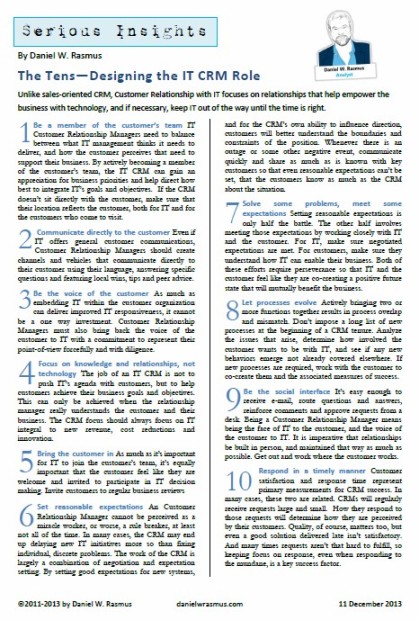 Unlike sales-oriented CRM, Customer Relationship Management within IT focuses on relationships that help empower the business with technology, and if necessary, keep IT out of the way until the time is right
Unlike sales-oriented CRM, Customer Relationship Management within IT focuses on relationships that help empower the business with technology, and if necessary, keep IT out of the way until the time is right
- Be a member of the customer’s team IT Customer Relationship Managers need to balance between what IT management thinks it needs to deliver, and how the customer perceives that need to support their business. By actively becoming a member of the customer’s team, the IT CRM can gain an appreciation for business priorities and help direct how best to integrate IT’s goals and objectives. If the CRM doesn’t sit directly with the customer, make sure that their location reflects the customer, both for IT and for the customers who come to visit.
- Communicate directly to the customer Even if IT offers general customer communications, Customer Relationship Managers should create channels and vehicles that communicate directly to their customer using their language, answering specific questions and featuring local wins, tips and peer advice.
- Be the voice of the customer As much as embedding IT within the customer organization can deliver improved IT responsiveness, it cannot be a one way investment. Customer Relationship Managers must also bring back the voice of the customer to IT with a commitment to represent their point-of-view forcefully and with diligence.
- Focus on knowledge and relationships, not technology The job of an IT CRM is not to push IT’s agenda with customers, but to help customers achieve their business goals and objectives. This can only be achieved when the relationship manager really understands the customer and their business. The CRM focus should always focus on IT integral to new revenue, cost reductions and innovation.
- Bring the customer in As much as it’s important for IT to join the customer’s team, it’s equally important that the customer feel like they are welcome and invited to participate in IT decision making. Invite customers to regular business reviews
- Set reasonable expectations An Customer Relationship Manager cannot be perceived as a miracle worker, or worse, a rule breaker, at least not all of the time. In many cases, the CRM may end up delaying new IT initiatives more so than fixing individual, discrete problems. The work of the CRM is largely a combination of negotiation and expectation setting. By setting good expectations for new systems, and for the CRM’s own ability to influence direction, customers will better understand the boundaries and constraints of the position. Whenever there is an outage or some other negative event, communicate quickly and share as much as is known with key customers so that even reasonable expectations can’t be set, that the customers know as much as the CRM about the situation.
- Solve some problems, meet some expectations Setting reasonable expectations is only half the battle. The other half involves meeting those expectations by working closely with IT and the customer. For IT, make sure negotiated expectations are met. For customers, make sure they understand how IT can enable their business. Both of these efforts require perseverance so that IT and the customer feel like they are co-creating a positive future state that will mutually benefit the business.
- Let processes evolve Actively bringing two or more functions together results in process overlap and mismatch. Don’t impose a long list of new processes at the beginning of a CRM tenure. Analyze the issues that arise, determine how involved the customer wants to be with IT, and see if any new behaviors emerge not already covered elsewhere. If new processes are required, work with the customer to co-create them and the associated measures of success.
- Be the social interface It’s easy enough to receive e-mail, route questions and answers, reinforce comments and approve requests from a desk. Being a Customer Relationship Manager means being the face of IT to the customer, and the voice of the customer to IT. It is imperative that relationships be built in person, and maintained that way as much as possible. Get out and work where the customer works.
- Respond in a timely manner Customer satisfaction and response time represent primary measurements for CRM success. In many cases, these two are related. CRMs will regularly receive requests large and small. How they respond to those requests will determine how they are perceived by their customers. Quality, of course, matters too, but even a good solution delivered late isn’t satisfactory. And many times requests aren’t that hard to fulfill, so keeping focus on response, even when responding to the mundane, is a key success factor.

Download a PDF of The Tens—Designing the IT CRM Role here.
The post The Tens—Designing the IT CRM Role appeared first on Daniel W. Rasmus.
